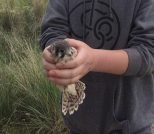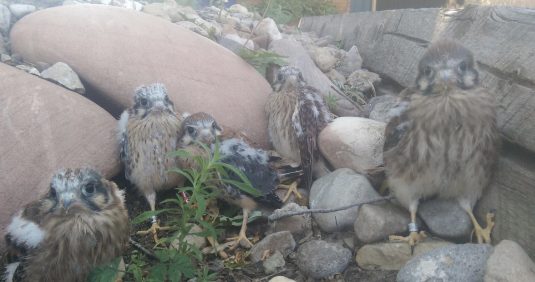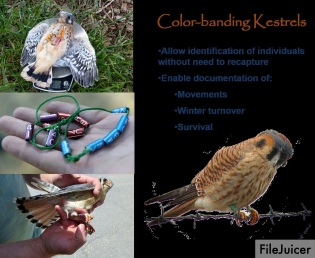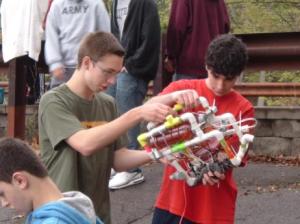community
HawkWatch International: Using Hands-on, Real-life Learning to Improve Student Achievement

What were the goals of the project?
The goals of the “Cavity Nester Citizen Science Study” fall into four categories:
- To improve science proficiency in local high school students by giving students the opportunity to participate in real scientific research.
- To get students outdoors as part of their education.
- To support the community and create community awareness of cavity-nesting species.
- To learn more about the movements, environmental impacts, and causes behind declining populations of local cavity-nesting birds and what we can do to conserve these species.
How were these goals achieved?

The project team hosted professional development workshops for teachers to introduce them to the project and explain how it supports the state’s curriculum. Lesson plans in biology, statistics, and environmental science were created. The lesson plans are shareable so the project can be replicated in other schools.
Students were trained how to properly monitor next boxes and cavities. HawkWatch International led trips for students to learn about and assist with banding birds. Utilizing their new skills, students monitored nest boxes and cavities near their school, conducted weekly habitat assessments, and recorded their data observations in field journals. They formulated hypotheses, analyzed the data collected, and formed conclusions about the birds being studied. Students presented their findings in a symposium open to their peers, families and the broader community.
What challenges were experienced along the way and how were they addressed?

Like most organizations, HawkWatch International was deeply affected by the COVID-19 pandemic. Of the four schools originally involved, two had to drop the program and the remaining two temporarily closed. Since they were unable to physically visit classrooms or take students out to check nest boxes, they were forced to pivot to virtual visits. The project later transformed into a hybrid approach, providing a mix of virtual and real-life visits to classrooms.
Exciting plans for the future:
HawkWatch International hopes to eventually pilot this project outside of the Wasatch Front in Utah to reach more students and transform them into conscientious environmental stewards eager to take an active role protecting the habitats of cavity nesting birds.
Additional resources:
CFCO: Service Learning Builds 21st Century Skills, Engages Teens
Connecting lessons learned in classrooms to real world applications is one of the great challenges in teaching. Teachers and administrators at Harrison High School in Evansville, Indiana have come up with an innovative new classroom model to address that challenge.
What is the CFCO?
They have created the Center for Family and Community Outreach (CFCO), which aims to use student skills (built around academic content) to create documents, multimedia, events, presentations, and more for over twenty non-profit organizations in their community.
Educators are able to connect students with members of the non-profit community, creating a symbiotic relationship wherein the student gains valuable real-life skills and the non-profits get a free service. Not only is it easier to engage teenage minds directly if they feel a sense of involvement and contribution towards the betterment of their community, it also helps teens build invaluable skills for the transition into their adult lives.
How can service learning support non-profits and drive engagement for learners?
There are many service learning projects around the country, but few, if any, that drives content in the classroom around producing products for non-profits. The CFCO model has elements of numerous trends in education, such as:

- project-based learning
- student-centered learning
- and new technology,
but is truly innovative for the level of engagement it produces for students.

This program has seven distinct goals.
- Research the non-profit groups and social issues in students’ communities.
- Hold ‘Round Table’ discussions with local experts on special topic issues using the latest online literature and information.
- Tour the non-profit facilities and volunteer with local organizations and events.
- Collaborate with leaders on project ideas and write formal proposals
- Use project based learning and technology to design and create materials
- “Pitch” their ideas through benchmarks and final presentations
- Openly communicate with the community through blogging and video reflections.
Importance of Community Support
Students are immersed in the tangible application of skills from the classroom, and since students know what they are doing will have a real impact on their community, it is readily apparent how seriously they take it. The program has relied on a tremendous amount of community support and is currently in it’s third year of operation. Fortunately they continue to draw in new non-profit partners based on the satisfaction of their initial partners and publicity the projects have generated for the mission of non-profits in Evansville.
What is the impact?
So where are the teachers and students of Harrison High School now, a year into the program? Reports have come back with very positive results, including:
- Students have a sense of ownership and engagement in their work as well as their community.
- Non-profit data shows that the community’s organizations have much higher perception of the schools and teens’ abilities after working with the CFCO.
Moving forward they plan on moving the program to a half day model, to increase student exposure, as well as continuing to nurture community involvement and contribution.

With such an easily adaptable model, educators around the country should be looking to Evansville, and Harrison High School in particular. How they proceed could very well dictate how dozens of similar programs pop up in the future. Community involvement and concrete links between lessons learned in the classroom and real world applications are key in both advancing education as well as building a student body that is invested in the present and future of their community. While the saying “It takes a village to raise a child,” has been politicized as of late, I think we can all agree that fostering a child’s investment and involvement in his or her village can only lead to positive results.
For more information
Related articles
- NSSE Results 2013 (teachingresearcher.wordpress.com)
- Creating Space for Marginalized Voices: Re-focusing Service Learning on Community Change and Social Justice (knrajlibrary.wordpress.com)
- Online Student is Set on ReStore-ing Ethics (blogs.msbcollege.edu)
Inquiry, Relevance, and Citizen Science: A Roadmap to Successful Science Projects
When students tackle science hands on, they can save the world!
If inquiry is meaningful, real world practices improve student understanding.

Memorizing the periodic table, a formula to determine the circumference of an atom, or the genus of a frog can be important, but let’s face it… you’re looking at an uphill battle when you are staring down the barrel of sixty drooping eyelids trying to explain why it is important that the student retain this information.
There is ample evidence that students retain very little from lectures in science classes. There is a reason for this – when you are given lists of equations, tables, or dozens of names to memorize it can be difficult to see where this makes an impact in the real world.
So how do we change this?
Simple. We help students impact the real world using practical inquiry into local and global science. Or better yet, take the classroom to the science! Whether students are contributing data to global honey bee research or graphing the skies, citizen science allows students to participate in global scientific inquiry. As explained here, integrating inquiry based science meaningfully in the real world is a tall order for any educator. In this post, we will share with you an example project and supporting resources to inspire this integration in your classroom.
How do educators integrate scientific inquiry and real world relevance?
The Water Quality Project: A Map to Understanding was reported by Linda Weber of Natick High School in Natick, Massachusetts. The goal of this project at is to let students “do” science like real scientists by observing, questioning, and ultimately coming up with a solution to a problem that can be shared with the larger community. In the short term, participation allows students to see and experience the process of scientific inquiry first hand, rather than having someone dictate it to them. In the long term, students who participated would see how the decisions they were making now would impact their lives in the future. According to the National Science Teachers Association’s position statement:
“Scientific inquiry reflects how scientists come to understand the natural world, and it is at the heart of how students learn. From a very early age, children interact with their environment, ask questions, and seek ways to answer those questions. Understanding science content is significantly enhanced when ideas are anchored to inquiry experiences. “
What strategies can be used to increase the real world relevance of the inquiry process?

One of the long term goals of this project included helping students see how the decisions they make today influences their future. This ambitious goal required teachers to frontload curriculum earlier in the year and to engage students with relevant narratives (like PBS’ Poisoned Waters) and a guest speaker assembly including local and regional water quality scientists.
All of this preparation helped students prepare for real world and hands on activities for the project. These included:
- Helping out their community
For the annual Charles River Watershed Association’s clean-up day, students and teachers removed a variety of trash, from traditional cigarette butts and paper to more unusual things like television sets. For the nearly 50 students that participated (on a school vacation weekend, mind you) the experience was insightful. Class discussions about and concern for their environment lingered into the following weeks in class. These shared experiences became the “reason” to investigate water quality in the community rather than the “just the wrap up activity” of the project.
-

Environmental Science and Robotics classes at collection sites test and launch robots, then collect water samples to be analyzed at the site and in class. Photo from Linda Weber, Project Awardee. Collecting local data
After the students had returned to the area to collect water samples. They used collection robots they built during their classroom time to reach water samples they couldn’t normally get to. Using technologies like wikis, blogs, and Google Maps they were able to share their results instantly with their classmates. - Contributing to global datasets
The project also included research for the testing parameters of The World Monitoring Day Organization or World Water Monitoring Day. The Water Quality Project isn’t the only program in the United States doing this. Many other schools (in over 24 countries) are participating in The World Water Monitoring Challenge. It charges its members to educate and engage students and citizens in the protection of international water resources.
- Presenting the results
When all the research was said and done there was a “massive poster presentation” where every student was required to present his or her findings and share ideas for how to improve the water conditions in their community.
Why does it work?
When learning is meaningful, the impact is tangible.
When students have the opportunity to showcase their skills to a larger audience than their teachers or peers it helps to internalize the lessons they learn in the classroom. This benefit accumulates when the students can see themselves using inquiry-based science to make a real difference in their communities.
Learn more about integrating Citizen Science in education
- British Science Association: The 3Rs of Citizen Science in Education
- Zooniverse
- Audrey Watters: Five Apps that Encourage Citizen Science

